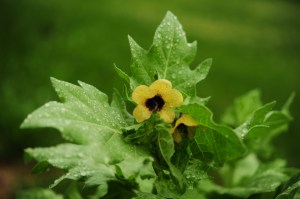Midsummer Nights’ Dreaming
Henbane, named lus ny meisht in Manx, has been variously ascribed to Jupiter; Gerard claiming that the plant was called Jupiter’s Beame by Pythagoras; or to Saturn, as postulated, (and in his own opinion proved), by Culpepper, based on where it grows.
But my experience of this plant’s genius, along with what we know of modern neurochemistry, make me inclined to consider this plant and its spirit to be quintessentially Lunar.
Aside from her traditional associations with goddesses of Witchcraft and of the Moon, henbane’s power and chemistry work almost entirely upon the nervous system. I tend to associate psychoactive plants with the domains of either Sun or Moon, depending on their actions. If one considers the vault of the skull to reflect a microcosm of the vault of the sky, then the luminaries of Sun and Moon are the primary lights affecting this part of the anatomy. They are also widely held to be the right and left eyes of God, allowing direct access to the Divine and the personal, individual Spirit. Pharmacologically, the alkaloids of the nightshade family are anticholinergic, binding to muscarinic and to a lesser degree, nicarinic receptors – physically affecting the fluids and autonomic functions of the body, and evoking sleep, dream, terror and stupefaction in the mind. Hyoscyamine and scopolamine, the main alkaloids found in henbane, affect the smooth muscle tissues of the body: those rhythmic undulations that occur beneath the level of conscious control. Henbane also pulls the fluids of the body inward, drying the peripheral mucosa, condensing and retaining the fluids in the hollow organs. This control of the bodily waters is held in common with the power of the Moon, as are the unconscious, the soporific, the primal, the terrifying and the oneiric.
Henbane’s morphology also suggests to me her Lunar energies: leaves that are fat, succulent and fragile, bearing long silver hairs that glisten in the dark and damp; flowers that are round and pallid with purple-brown irregular spotting coalescing in the throat of the blossom. The flowers bear five petals and later produce an abundance of tiny round seeds contained within a capsule which is sealed until ripe by a tiny circular lid. Once germinated, Hyoscyamus niger grows with astounding rapidity provided there is sufficient moisture. A strong, narcotic smell is released at the slightest touch of any part of the plant, evoking her anodyne properties, sleep and dream.
Henbane has traditionally been used to relieve pain in cases where opiates are ineffective or undesirable. She has also been used to calm the mind and induce sleep in cases of insomnia. Overdose of the plant dilates the pupils, causes dimness of sight, delirium, profound sleep that may be prolonged for days, and death. All in accordance with the most extreme effects of the Moon. Her dual faces, causing stimulation at lower doses and sedation at higher ones, also align her with the bright and dark faces of the Lunar Orb.
Several of these effects may also be aligned with Saturn, but in my experience, Saturnine energies have more to do with decay, degeneration and permanent loss of mental and physical faculties than with the transient, seemingly alien narcotic undermining of the waking consciousness that typifies henbane intoxication.
Saturnine plants also tend to be slow growing, physically expressing the slow, plodding pace of their planetary ruler.
Historically, the magicks of this plant are those relating to thanatotic workings, to love and to theriomophism, also suggesting that she belongs within the Lunar Mansion.
Of all the seeds I planted this year, henbane has been the most generous, amenable and prolific in her growth. She and her sister, belladonna, have overshadowed all the other veneficii in my garden. I regard this as in indication that I have work to do, and much to learn from these plants this year. Combining this with the wild plants I have found in my wayfaring, and happening upon formulae that call for these specific plants together, I am directed in my research and explorations at this time through this specific region of the plant world.
Buhner has a useful section addressing henbane and recipes using it in his, Sacred Herbal Healing Beers, and Schulke has worthwhile research and experience to add in his, Veneficium. I sincerely hope he will share his Hypnotikon with an appropriate, educated and eager audience one day.



Leave a comment